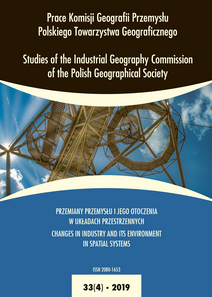Wybrane kierunki i aspekty przemian funkcjonalnych terenów przemysłowych we Wrocławiu w latach 1989–2016
Selected Directions and Aspects of Functional Changes of Industrial Areas in Wrocław in 1989–2016
Author(s): Dominik SikorskiSubject(s): Environmental Geography, Local History / Microhistory, Rural and urban sociology, Transformation Period (1990 - 2010), Present Times (2010 - today)
Published by: Wydawnictwo Uniwersytetu Komisji Edukacji Narodowej w Krakowie
Keywords: functional changes; industrial areas; Wrocław;
Summary/Abstract: The spatial structure of cities in post-1989 Poland underwent significant transformations. The urban areas that significantly changed their image were industrial areas. Due to their attractive location in the city, they were susceptible to new processes and socio -economic phenomena. As a result of these changes, entities of a function other than production entered the uniform industrial site. The process of functional succession was observed. The aim of the study is to indicate the most important directions and aspects of functional changes of industrial areas in Wroclaw in the years 1989–2016. The article was created on the basis of REGON data analysis (1999, 2004, 2009 and 2016) and field studies. The process of changing the functions of industrial areas has significantly changed most of the city’s production areas, causing morphological and physiognomic changes, as well as functional and social changes. The dynamics of changes in the functions of this type of urban areas are mainly influenced by the specificity of their location (proximity to the city centre, location relative to the main transport routes of the city), type of industrial activity, technical condition of buildings, financial condition of the industrial plant and many other factors. The studied process is often an unplanned transformation with uncontrolled change dynamics.
Journal: Prace Komisji Geografii Przemysłu Polskiego Towarzystwa Geograficznego
- Issue Year: 33/2019
- Issue No: 4
- Page Range: 227-240
- Page Count: 14
- Language: Polish

